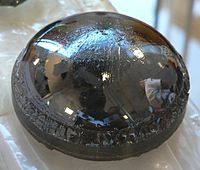
Photo from wikipedia
Abstract Simulations based on density functional theory (DFT) were used to investigate the behaviour of substitutional iron in both tetragonal and monoclinic ZrO2. Brouwer diagrams of predicted defect concentrations, as… Click to show full abstract
Abstract Simulations based on density functional theory (DFT) were used to investigate the behaviour of substitutional iron in both tetragonal and monoclinic ZrO2. Brouwer diagrams of predicted defect concentrations, as a function of oxygen partial pressure, suggest that iron behaves as a p-type dopant in monoclinic ZrO2 while it binds strongly to oxygen vacancies in tetragonal ZrO2. Analysis of defect relaxation volumes suggest that these results should hold true in thermally grown oxides on zirconium, which is under compressive stresses. X-ray absorption near edge structure (XANES) measurements, performed to determine the oxidation state of iron in Zircaloy-4 oxide samples, revealed that 3 + is the favourable oxidation state but with between a third and half of the iron, still in the metallic Fe0 state. The DFT calculations on bulk zirconia agree with the preferred oxidation state of iron if it is a substitutional species but do not predict the presence of metallic iron in the oxide. The implications of these results with respect to the corrosion and hydrogen pick-up of zirconium cladding are discussed.
Journal Title: Journal of Nuclear Materials
Year Published: 2018
Link to full text (if available)
Share on Social Media: Sign Up to like & get
recommendations!